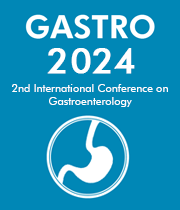Title : Liver actinomycotic abscess - A rare complication of gastro-oesophageal reflux disease related mucosal injury
Abstract:
Background:
Actinomycosis is a bacterial infection caused by Gram positive, non-acid fast, anaerobic or microacrophilic rods. Actinomycetes can be found in the normal flora of the oral cavity, as well as less commonly in the lower GIT and female genital tract but are not virulent. Actinomycosis of the abdomen and pelvis accounts for 10-20% of reported cases. Untreated, pyogenic liver abscess remains uniformly fatal. With timely administration of antibiotics and drainage procedures, mortality currently occurs in 5-30% of cases. The most common causes of death include sepsis, multiorgan failure, and hepatic failure.
Aims:
The purpose of this case report is to highlight the potential connection between GORD, mucosal injury and actinomycotic liver abscesses.
Case:
This is a case report of 57 year old male presenting with flu like symptoms, high fever, myalgia and very mild right upper quadrant pain. There was no medical history of note. Initially treated as infection of unknown source. Blood cultures ultimately grew actinomycosis oris. CT Abdomen/Pelvis showed an 8.5cm liver abscess, predominantly located within segment 5. Some mural thickening of the distal oesophagus with periesophageal and coeliac axis lymph nodes was also noted. He was followed up with OGD which showed a hiatus hernia and gastritis. Treatment was with IV antibiotics (piperacillin/tazobactam) for 6 weeks and CT guided drainage of the abscess. The drain was removed after 3 weeks.
Results and discussion:
As found in literature to date, risk factors include previous abdominal/pelvic surgery, abdominal wall trauma, gastrointestinal foreign body, gastrointestinal tract lesions and immunosuppression. Although the cause in the majority of cases is unknown (80.7%), the abscess can appear after any disruption in mucosal integrity (Christodolou et al 2004). In absence of other risk factors, this patient had a hiatus hernia, gastritis, and oesophageal thickening which suggest untreated gastro-oesophageal reflux disease. This could have led to the loss of integrity of the gastrointestinal mucosa. Mucosal injury or infection may cause involvement of the liver through hematogenous spread via the portal vein resulting in a liver abscess. This could suggest a potential link between GORD, mucosal injury and liver actinomycosis. Treatment options available comprise of antibiotics, surgical resection and percutaneous drainage, either separately or together, and can take from 1 to 6 months. There are no current guidelines for therapy. Based on existing studies, antibiotics seem to be effective in treating the infection. Surgery should be used as last resort in cases where percutaneous drainage is not possible or where necrotic tissue is present.
Conclusion:
From the evidence presented in this case report, there is a potential link between mucosal injury due to untreated GORD and hepatic actinomycotic abscess.



